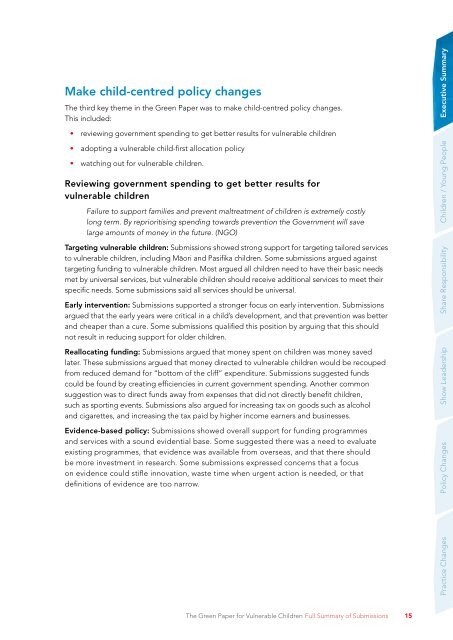The Green Paper for Vulnerable Children - Ministry of Social ...
The Green Paper for Vulnerable Children - Ministry of Social ...
The Green Paper for Vulnerable Children - Ministry of Social ...
Create successful ePaper yourself
Turn your PDF publications into a flip-book with our unique Google optimized e-Paper software.
Make child-centred policy changes<strong>The</strong> third key theme in the <strong>Green</strong> <strong>Paper</strong> was to make child-centred policy changes.This included:• reviewing government spending to get better results <strong>for</strong> vulnerable children• adopting a vulnerable child-first allocation policy• watching out <strong>for</strong> vulnerable children.Reviewing government spending to get better results <strong>for</strong>vulnerable childrenFailure to support families and prevent maltreatment <strong>of</strong> children is extremely costlylong term. By reprioritising spending towards prevention the Government will savelarge amounts <strong>of</strong> money in the future. (NGO)Targeting vulnerable children: Submissions showed strong support <strong>for</strong> targeting tailored servicesto vulnerable children, including Māori and Pasifika children. Some submissions argued againsttargeting funding to vulnerable children. Most argued all children need to have their basic needsmet by universal services, but vulnerable children should receive additional services to meet theirspecific needs. Some submissions said all services should be universal.Early intervention: Submissions supported a stronger focus on early intervention. Submissionsargued that the early years were critical in a child’s development, and that prevention was betterand cheaper than a cure. Some submissions qualified this position by arguing that this shouldnot result in reducing support <strong>for</strong> older children.Reallocating funding: Submissions argued that money spent on children was money savedlater. <strong>The</strong>se submissions argued that money directed to vulnerable children would be recoupedfrom reduced demand <strong>for</strong> “bottom <strong>of</strong> the cliff” expenditure. Submissions suggested fundscould be found by creating efficiencies in current government spending. Another commonsuggestion was to direct funds away from expenses that did not directly benefit children,such as sporting events. Submissions also argued <strong>for</strong> increasing tax on goods such as alcoholand cigarettes, and increasing the tax paid by higher income earners and businesses.Evidence-based policy: Submissions showed overall support <strong>for</strong> funding programmesand services with a sound evidential base. Some suggested there was a need to evaluateexisting programmes, that evidence was available from overseas, and that there shouldbe more investment in research. Some submissions expressed concerns that a focuson evidence could stifle innovation, waste time when urgent action is needed, or thatdefinitions <strong>of</strong> evidence are too narrow.Practice Changes Policy Changes Show Leadership Share Responsibility <strong>Children</strong> / Young People Executive Summary<strong>The</strong> <strong>Green</strong> <strong>Paper</strong> <strong>for</strong> <strong>Vulnerable</strong> <strong>Children</strong> Full Summary <strong>of</strong> Submissions15
















